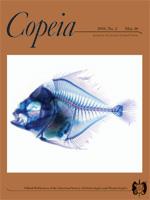The monotypic Indo-Pacific genus Parastromateus Bleeker, 1864 is morphologically peculiar among carangid fishes in its overall body form and has been difficult to place phylogenetically. This has been partly the result of a lack of detailed morphological data for this and other carangid fishes. Here, we describe and analyze the osteology of Parastromateus niger (Bloch, 1795), review its taxonomic history, and describe characters that are suggestive of its phylogenetic affinities. In addition, we made a broad survey of gill-arch skeletal characters for carangids. Previous studies have noted that a combination of features from the skeletal anatomy of Parastromateus firmly places it within the Carangidae (presence of a gap between the second and third anal-fin spine) and within the tribe Carangini (presence of scutes, inferior vertebral formina). Within the Carangini, however, its phylogenetic placement is less clear. In our survey of the gill arches of Carangidae, we found that only Parastromateus and Hemicaranx have an enlarged toothplate that bridges the epibranchial 4–ceratobranchial 4 joint. Additionally, these two genera have a superficially similar form of teeth on the pharyngeal toothplates (elongate and filamentous vs. conical and stout in other carangins). Although outside the scope of our study, these and other morphological aspects of Parastromateus need to be brought into a broad-based cladistic analysis of the Carangidae.
How to translate text using browser tools
20 May 2010
Osteology and Systematics of Parastromateus niger (Perciformes: Carangidae), with Comments on the Carangid Dorsal Gill-Arch Skeleton
Eric J. Hilton,
G. David Johnson,
William F. Smith-Vaniz
ACCESS THE FULL ARTICLE





